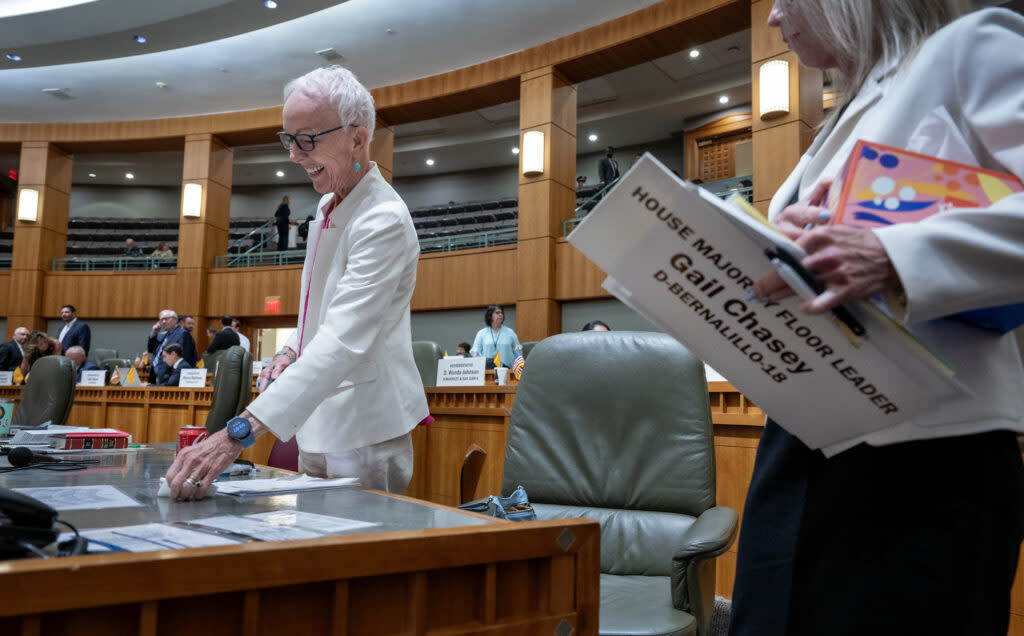NM House lawmakers introduce one bill at special session, bypassing most of NM Gov’s crime agenda

- Oops!Something went wrong.Please try again later.
House Maj. Leader Gail Chasey (D-Albuquerque) packs up her desk after a special session to address public safety adjourns without taking up most of the Governor's bills. Chasey is retiring from the legislature at the end of the year. (Photo by Eddie Moore / Albuquerque Journal)
On the first day of the special legislative session, New Mexico House lawmakers introduced a single piece of legislation that would fund a few months of assisted outpatient pilot programs and provide grants and loans for wildfire response – but otherwise ignores much of Gov. Michelle Lujan Grisham’s special session agenda.
The bill, HB 1, also allocates about $212,000 to fund the ongoing special session, which convened at noon Thursday amid ongoing strife between the governor and Democratic legislative leaders.
Leaders, this week, said the governor is trying to rush through legislation regarding the complicated interplay of mental illness, drug use and crime. They said they need more time to create and deliberate laws that represent real solutions, while the governor has said the current crisis demands immediate action.
A key House committee quickly endorsed the legislation Thursday afternoon by a vote 15-1. It will shortly be heard on the House floor and, if approved, will be sent to the Senate.
The lone House bill, sponsored by two Democrats and two Republicans, would give $3 million to the state Administrative Office of the Courts to pay for pilot programs related to assisted outpatient treatment and competency diversion pilot programs.
While the governor is seeking reforms to the laws governing these kinds of behavioral health programs, the House bill would leave the law untouched and simply fund existing programs or those that are already legal.
Rep. Gail Chasey (D-Albuquerque), one of the sponsors, told the House Appropriations and Finance Committee that the pilot programs are geared toward programs in the First, Second and Third judicial districts that are already designed or up and running.
The assisted outpatient treatment program in the Second, in Bernalillo County, restarted in the first week of July after being suspended because it did not have enough providers on board. The programs in the First in Santa Fe County and the Third in Doña Ana County still need to be started, according to a July 10 memorandum by officials from the Administrative Office of the Courts.
Each of the AOT programs currently rely on local funding, the memo states, making it hard to recruit providers and staff.
The judicial branch is also planning three misdemeanor competency diversion pilot programs, in which people who are accused of low-level crimes and are found to be unable to understand or participate in their own legal defense get connected to navigators who offer them treatment and services.
Competency diversion programs are planned for the Third judicial district, the Fourth in San Miguel County and the Twelfth in Otero County, according to the memo. Court officials want to make those programs permanent and add an additional diversion site in the First.
The funding would allow them to operate or grow until the 60-day legislative session convenes in January 2025, and then the Legislature could re-evaluate whether they work, Chasey said.
The bill also would provide $100 million in loans and grants to help individuals and local governments responding to the South Fork and Salt Fires in southern New Mexico.
Most of that – $70 million – would be in the form of zero-interest loans to local governments who incurred large expenses responding to the fires and ongoing floods. The state expects those loans would be repaid via the Public Assistance program from the Federal Emergency Management Agency. The state passed a similar loan package after the Hermits Peak-Calf Canyon Fire in 2022, citing the often-slow release of funds from FEMA’s Public Assistance program.
The bill would also provide $10 million apiece to the state Department of Homeland Security and Emergency Management, the Energy, Minerals and Natural Resources Department and the Indian Affairs Department.
DHSEM, the state’s emergency response department, would use the money primarily to assist families and businesses; EMNRD would use it for wildfire mitigation, erosion control and watershed restoration, among other programs to prevent or repair damage from ongoing floods.
The final $10 million to the state Indian Affairs department will go to help the Mescalero Apache Reservation for damages and losses it incurred.
In committee, lawmakers did not publicly mention the other aspects of the governor’s agenda not included in the lone piece of legislation, including her efforts to pass legislation affecting criminal competency, involuntary commitment and loitering on medians.
But they did praise, in particular, the $100 million for fire victims, saying it was an example of the Legislature acting quickly to help those affected by the disaster, which destroyed an estimate 856 homes and killed two people, along with additional fire and flood damage that continues today.
“It’s not going to fix things, but it will, again, immediately make things a little bit better,” said Rep. Nathan Small (D-Las Cruces), who chairs the committee, of the disaster grants and loans.
The bill passed nearly unanimously, with one lone “no” vote from Rep. Randall Pettgrew (R-Lovington). Pettigrew criticized his fellow lawmakers for including additional legislation in the bill that is ordinarily designed just to fund the session itself, known as the feed bill.
He said he supported the provisions in the bill but thought they should be each introduced and voted on as separate legislation, which is why he cast the sole vote against the bill.
Senior Reporter Austin Fisher contributed reporting to this story.
The post NM House lawmakers introduce one bill at special session, bypassing most of NM Gov’s crime agenda appeared first on Source New Mexico.

